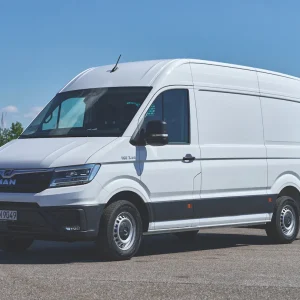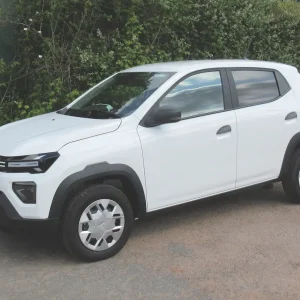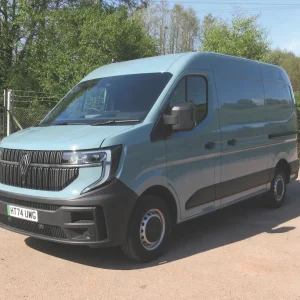Brembo is a global company and it's a real surprise to discover just how many light commercials are equipped with its products as standard. Citroën Relay, Fiat Ducato, Iveco Daily, Mercedes Vito/Sprinter, Nissan Cabstar and the Peugeot Boxer, to mention some of them.
So, Brembo is already pretty well established in the LCV world, although unlike in the car market there are no visual clues. Just take a look at the wheels on a Porsche next time you see one parked up and the unmistakable red brake caliper housings are from Brembo, and probably marked as such. Those on AMG Mercs bearing the 'AMG' monicker are also from Brembo.
Brembo is also a big player in the Truck market and the projected figures for 2008 suggest that it will hold a European market share of 48 per cent for light trucks.
Electronic Parking Brake
Next year's huge Amsterdam Commercial Vehicle Show (29 Oct – 7 Nov) will see Brembo launch an all-new product, the Electric Parking Brake (EPB) Cable Puller. It's an electro-mechanical system which replaces the conventional handbrake lever, whether floor- or facia-mounted, with a switch on the dashboard, or anywhere else a manufacturer decides to site it; on the steering wheel, for example.
Similar systems already exist in the car market, but these tend to differ in one fundamental area. The parking, or service, brake which generally acts on the rear wheels is operated by a small motor integrated into the caliper housing on each wheel.
Now, this is fine in a passenger car when on average a force of 20kg is required to fully lock the service brake, but on a light commercial the figure is closer to 40kg. In the Brembo EPB system for vans service brake activation remains cable-operated.
Cable Operated
One of the beauties of using this approach is that the original service brake components remain unchanged so there is no problem at all for manufacturers to offer this system as an optional extra and have it fitted on the production line.
There are several other plus-points. It can be fitted to any light commercial with a cable-operated service brake system and this is regardless of the wheelbase or whether the vehicle is a van or chassis cab.
 EPB Actuator
EPB Actuator
At the heart of Brembo's EPB lies the Actuator assembly. This resides anywhere suitable under the rear of the vehicle where it can be bolted rigidly. Cables are then attached to the service brake system.
Inside the box there's a small electric motor which acts on the gear-puller units and an Electronic Control Unit (ECU). The ECU contains bespoke software which integrates with the vehicle's Can-Bus system to retrieve data such as engine revs and wheel speed, while 'talking' to the gearbox. On/off control is taken care off by the in-cab switch.
Joint Development
Development of the system was done in conjunction with Magna Power Train (MPT). Brembo is responsible for the technical specification, system validation, vehicle integration, software development and supply to the customers.
MPT takes care of the actuator and ECU design, testing and validation before supplying to Brembo.
 On the Road
On the Road
We were given a brief opportunity to accompany a Brembo test driver around a short on-site road circuit to see for ourselves how the system operates.
At the time of our visit the system was still undergoing the final stages of development so the cab of the test vehicle, a 3-litre CNG-powered Iveco Daily chassis cab dropside, was littered with instrumentation. This vehicle was being used as Brembo reckons this particular engine is the most difficult to integrate with the system thanks to its fuel source and the complex nature of the engine management system.
EPB couldn't be simpler to use. Pull up at the side of the road or at a set of traffic lights and push the button on the dashboard. The service brake is then engaged. The brake is released by pushing the button again or it will deactivate automatically once the clutch is released to move off. It's that easy.
Stop on a hill and it works in exactly the same way, only this time it is noticeable that there is a short gap between deactivating the system manually and it disengaging. Alternatively, the driver can just drive off and let the service brake release automatically. In effect it acts as a hill-holder without involving the ABS system.
Brembo did want us to point out that the dash-mounted button in the cab of the test vehicle was for demonstration purposes only. Manufacturers who decide to offer the EPB will be able to integrate the on/off button however they please aesthetically.
Brembo
Brembo's headquarters are situated in Stezzano, just outside Bergamo and close to Milan, but it also has facilities in 13 other countries, including the UK (Ap Racing), North and South America, China and Japan.
It employs 5,700 people worldwide, 450 of whom work in the R & D department at the HQ. It prides itself on keeping the whole production cycle in-house, from foundry to final manufacture, which means it is in full control of every aspect of build quality.
Supplying everything from entire pre-bled brake modules to individual brake system components — calipers, disc pads, drum-in-hat parking parking brakes — Brembo provides products for motor bikes (including wheels), passenger cars, light commercials and trucks; up to 40-tonners.
Motor sport is used as an advanced experimental laboratory and Brembo has supplied teams in Formula 1, World Rally Championship, Indycar, Nascar, Superbike and Enduro to name but a few.
Wordwide production capacity per annum is 40m brake discs, 6.3m calipers, 575,000 brake modules and 180,000 motorcycle wheels. The foundries are capable of producing 120,000 tonnes of cast iron and 21,000 tonnes of aluminium.
VERDICT
We really like Brembo's approach to the EPB. It's simple and effective, and by retaining a vehicle's existing service brake components should make it a relatively cheap option. The really clever bit, however, is that it will work on any model in a specified range with a GVW of between 2.8 tonne and 7.0 tonne, regardless of configuration or wheelbase.

 A van's braking system is one of those essential items which most van owners never give a second thought, so long as it's functioning correctly. Manufacturers don't tend to make their own brakes, however, but source them externally from specialists. One of these suppliers is Italian company Brembo as anyone interested in motor sport or high performance cars will undoubtedly be aware.
A van's braking system is one of those essential items which most van owners never give a second thought, so long as it's functioning correctly. Manufacturers don't tend to make their own brakes, however, but source them externally from specialists. One of these suppliers is Italian company Brembo as anyone interested in motor sport or high performance cars will undoubtedly be aware. EPB Actuator
EPB Actuator On the Road
On the Road



